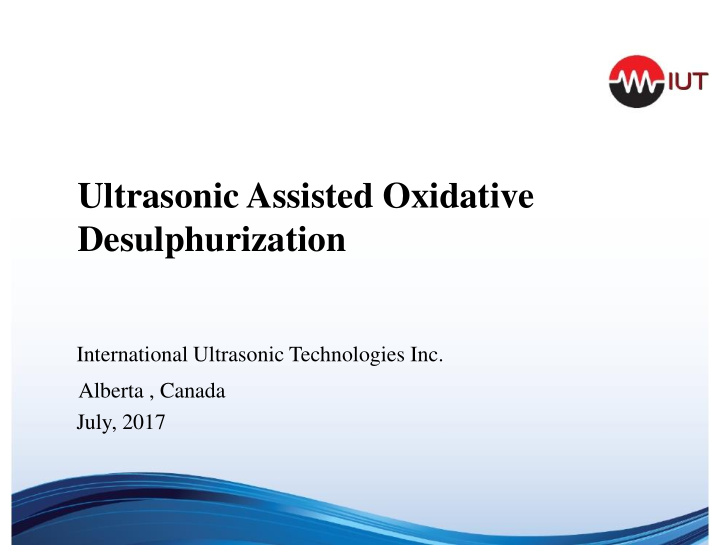



Ultrasonic Assisted Oxidative Desulphurization International Ultrasonic Technologies Inc. Alberta , Canada July, 2017
Executive Summary • IUT is a private company based in Calgary, Alberta Canada, developing and commercializing a proprietary ultrasonic-assisted oxidative desulfurization (“UAOD”) technology. • IUT owns eight US related patents. • IUT’s process has been field tested in a US refinery and successfully reduced sulfur content in refined oil products by at least 97%. • The technology is applicable to different petroleum products including natural gas liquids (NGL), gasoline, kerosene and diesel, reducing the Sulphur content to 10 parts per million (ppm) or less, meeting or exceeding the ultra low sulfur (ULS) transportation fuel standards of most countries. • Our company is currently seeking industry partners to further develop and market our technology .
Desulphurization Regulatory Landscape Complicated, Confusing and Challenging Country/Application Fuel Current Regulations 2020 Regulations Diesel 30ppm 15 ppm Canada/US Gasoline 30ppm 10 ppm China Diesel/Gasoline 50 ppm 5 ppm India Diesel 50 ppm 10 ppm Africa Diesel/Gasoline 50 ppm 10 ppm Europe Diesel/Gasoline 10 ppm 10 ppm Marine Shipping Heavy Fuel Oil 3.5% (35,000 ppm) .5% (5,000 ppm) (HFO)
Technology Highlights • Ultrasonic decreases oxidation reaction time and increases sulfur conversion efficiency with very low residence times (<500 ms). • The oxidized sulfur compounds after treatment exhibit high solubility in water allowing for easy separation of the sulfur from the hydrocarbon stream. • Instead of complex post-processing separation, removal of the oxidized sulfur compounds can be achieved via a basic water wash. • Resulting treated hydrocarbon stream has a sulfur content of 10 ppm and potentially less • More cost effective than traditional hydrodesulphurization (“HDS”)
Process Flow Diagram Adsorption and solvent Oxidation and Phase Separation Ultrasonic Processing regeneration (used only for more complex aromatic sulfur compounds)
Process Unit Description Highlights • Capacity: 6,000 barrels per day oil with double lines • 20’X 6’ Size: • Operating costs: $1.50 per barrel including power, ultrasonic wearable parts and catalyst • Power requirements: 75 - 95 KWatts at 480 Voltage, 3 Phase for double line unit • Lifecycle: 20 years excluding wearing parts
Successful Commercial Validation Trial in Texas • The first US commercial – scale trials reduced sulfur in Natural Gasoline from 150-500 ppm to less than 12 ppm • Average operating costs were $1.0/bbl. • Feed rates of up to 3,000 BPD of oil stream
Desulphurization Relative Difficulty Sulfur in refined fuel streams generally occurs from the following compounds: Source: Hydrotreating (Engineering Design Guidelines), KLM Technology Group
Challenges of Traditional Hydrodesulphurization (“HDS”) CH 3 H CH 3 CH 3 CH 3 H H H H S H H H H + 5 H 2 + H 2 S H P > 800 psi H H H H H T > 650 F H H H H H • Capital costs: high • Operating costs: high utilities, labour, catalyst use, hydrogen • Operating complexity: high pressure, high temperature, safety • Efficiency: less effective at converting complex cyclic sulfur compounds • Carbon footprint: hydrogen use and energy (heat/pressure) use
Benefits of IUT Technology (ODS) O O S S Δ T + Oxidant + 2 H 2 O Catalyst DBT DBTS Dibenzothiophene Sulfone Dibenzothiophene • Capital costs: lower relative to HDS • Operating costs: low utilities, lower labor, catalyst cost and regeneration use, no hydrogen • Operating complexity: low pressure, low temperature, safe • Efficiency: very effective at converting complex compounds abundant in hydrocarbon streams • Carbon footprint: lower energy use
Summary: HDS vs ODS Traditional HDS IUT ODS Hydrogen addition Yes No Pressure 2000 PSI 50 PSI or less 300-400 o C 80 o C or less Temperature Equipment cost $1,000/barrel/day 40% or less of HDS Operating costs $4-5/bbl. $ 1.5 / bbl. Movable No Yes Modular and No Yes capacitive Removal Less effective removal of Sulphur Effective with all Sulphur of complex sulphur in cyclic compounds compounds compounds Operation Complex, several operators Simple, 1 to 2 operators Effect on octane/cetane Reduced No effect number
Markets Refiners Crude Producers Shipping Industry Power Generation
Advancing Technology – Shipping • International Marine Organization (“IMO”), the sulfur content in marine fuel to be reduced from the current 3.5% to no more than 0.5% worldwide starting in 2020. More stringent requirements is now imposed in Europe - 0.1% of Sulphur. • There are over 90,000 ships and many ports/terminals worldwide that serve as a potential market . • HDS is not practical: – Catalyst poisoning of the residual fuel by heavy metals – Less efficient (can only achieve ~1% sulfur) – Very costly. • UAOD is the solution: – No risk of catalyst poisoning – Efficient – can achieve <5ppm – Inexpensive, modular and relatively easy to implement
SUMMARY • Cost effective, scalable solution to developing market for hydrocarbon fuel desulphurization • Applicable to a broad range of feed fuels (gasoline, naphtha, diesel, marine fuel, etc.) • Economic and regulatory demand drivers • Carbon footprint minimization • Proven technology: commercial trials have demonstrated effectiveness of process, scalability and commercial readiness
Recommend
More recommend